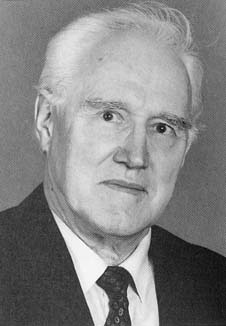<Back to Index>
- Mathematician Hans Jürgen Hoehnke, 1925
- Painter Sigrid Hjertén, 1885
- Prime Minister of Italy Giovanni Giolitti, 1842
PAGE SPONSOR

Hans-Jürgen Hoehnke was born in the Free City of Danzig at a time when it was a free city under the protection of the League of Nations. His parents, like most of the inhabitants of Danzig, were German. His father worked in a bank in the city. Although the city had its own government, most of the population favoured its incorporation into Germany. It was not surprising, therefore, that in 1933 the Nazi party gained control of the government of the city, although at this stage it was still under the protection of the League of Nations. Germany attacked Danzig in September 1939 as their armies marched into Poland. The Poles defended the city for a week before running out of ammunition, at which point the Germans took control, annexing the city and incorporating it into the Reichsgau Danzig - West Prussia. Hoehnke was fourteen years old at this time and had become interested in short wave radio. This was an interest which was viewed with suspicion by the Nazis so Hoehnke decided that he would look for another topic to pursue - he chose mathematics and physics and concentrated on these subjects for the rest of his school career.
In 1943 Hoehnke graduated from school following the Abitur but given the wartime conditions there was no possibility for him to progress to a university education at that time. He attended the German Air Force School and only after the end of World War II was he able to continue his education. The Soviet army captured Danzig in March 1945 and the bombardment flattened most of the city. Hoehnke then began studying mathematics at university and was awarded his doctorate by the Martin Luther University in Halle - Wittenberg in 1952 after undertaking research under Heinrich Brandt. From 1956 until his retirement in 1990, Hoehnke worked at the Mathematical Institute of the Academy of Science of the German Democratic Republic. Reinhard Pöschel writes:
My thoughts go back more than 25 years to the time [around 1970] when, still a student, I first met H-J Hoehnke. With the reform of universities in the German Democratic Republic, algebra as an independent discipline was eliminated at the Technical University of Dresden, and it was mainly due to the personal efforts of H-J Hoehnke that I was able to begin and successfully complete my research studies in algebra under his supervision [Pöschel was awarded his doctorate for his thesis Postsche Algebren und invariante Relationen über einer Familie endlicher Mengen by the Technische Universität Dresden in 1973]. I experienced similar help with political difficulties. From him I was able to learn what it means to live uprightly without making compromises, answering only to one's own conscience. Only those who are familiar with the conditions in the German Democratic Republic can appreciate the difficulties and disadvantages connected with such an upright attitude (for example, despite being highly qualified in his field, H-J Hoehnke could never become a professor.
Hoehnke's early papers include Über die definierenden Gleichungen für Matrizeneinheiten in primären Ringen (1956) in which he looks at multiplicative semigroups inside matrix rings over completely primary rings, Identische Kongruenzen für Polynome nach zusammengesetzten Moduln (1956), and Nilpotenzkriterien (1957) in which he looks at conditions on a ring which force certain radicals to be nilpotent. He continued to examine rings and algebras in papers such as Lösung eines Problems von Ch Hopkins (1957), Über komponierbare Formen und konkordante hyperkomplexe Grössen (1958) and Konstruktive Methoden in der Theorie der Algebren (1960). In 1962 he published his first paper entitled Zur Theorie der Gruppoide with a second and third part appearing in the same year. Parts 4, 5, 6, 7, 8 and 9 appeared in 1963. In this series of papers he investigates the structural relations between Brandt groupoids, Ehresmann groupoids, semigroups, Brandt semigroups, categories and groups. Around this time, almost certainly motivated by his investigation of groupoids, he embarked on an ambitious programme to examine the structure theory of semigroups. Márki explains this programme:
Although Hoehnke continued to keep these interests, he also became interested in universal algebras, automata, categories and functors. He published papers on these topics such as Heterogeneous monoid automata and admissible bisystems (1978), On quasivarieties of partial algebras, their generation and their subquasivarieties (1986), On certain classes of categories and monoids constructed from abstract Malcev clones (1995), and Quasi - varieties: a special access (2004).The bulk of Hoehnke's work on semigroups relies on ring theory and is based on the observation that, in most aspects, congruences of semigroups play the role of ideals of rings. One cannot transcribe results, however, simply by replacing ideals by congruences, since there are in general non-equivalent ways of defining the congruences which should correspond to a given kind of ideals. ... In the introduction of the paper [Zur Strukturtheorie der Halbgruppen (1963)] he outlines an ambitious program as follows. The natural starting point for the structure theory of semigroups is the theory of transformation semigroups, in parallel to Jacobson's structure theory of rings which uses linear transformations of vector spaces. The main directions of this theory should be: the theory of (0) - primative semigroups, the 0 - radical, simplifications of the theory under finiteness conditions, a study of the congruence lattice, Kronecker products (coming from matrix theory) for semigroups and acts, topological methods, comparison of the left- and right-sided behaviour of a semigroup and finally, finding the place of all former results ... in this theory.